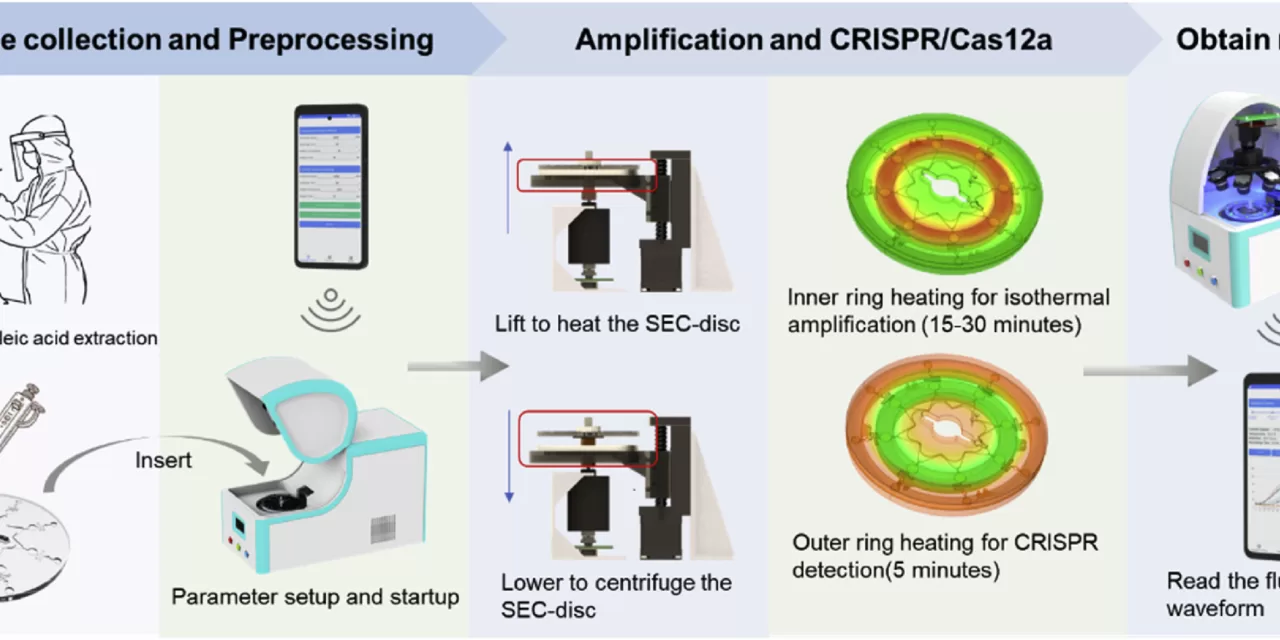A team of researchers from the Hefei Institutes of Physical Science of the Chinese Academy of Sciences has developed a groundbreaking point-of-care testing (POCT) system utilizing microfluidic CRISPR-Dx technology. This innovation significantly enhances the sensitivity, speed, and multiplexing capability of pathogen detection, paving the way for more efficient and accessible diagnostic solutions.
The research findings were recently published in Biosensors and Bioelectronics.
Advancements in CRISPR-Based Diagnostics
CRISPR/Cas-based molecular diagnostics have proven to be a highly precise method for detecting specific gene sequences in pathogens, including genetic mutations and abnormalities. This ability makes CRISPR-Dx a valuable tool in disease diagnosis and treatment. However, existing CRISPR-based diagnostic methods face limitations such as low sensitivity, limited multiplexing capacity, and the requirement for multiple laboratory instruments. These constraints make it challenging to implement the technology in rapid, point-of-care settings.
To overcome these challenges, the researchers integrated microfluidic chips with CRISPR/Cas12a technology to develop a dual-stage system that separates amplification and detection processes. This innovation, combined with a two-stage centrifugation method, prevents contamination and enhances testing efficiency. Furthermore, the system features customizable detection channels, allowing for improved sensitivity and simultaneous multi-pathogen detection.
The Lift-CM POCT System: A Game-Changer in Diagnostics
The newly developed Lift-CM POCT analysis system comprises a heating platform, a centrifugation module, and a real-time fluorescence detection unit. Designed for compactness and ease of use, the system is controlled via a smartphone application, reducing dependency on multiple laboratory instruments. This user-friendly approach makes CRISPR-Dx technology more practical, particularly in resource-limited environments.
“Lift-CM is faster and easier to use than traditional CRISPR methods,” said Dr. Zhu Cancan, a member of the research team. “It is highly effective for accurately detecting viruses such as influenza and Ebola.”
One of the most remarkable aspects of the Lift-CM system is its efficiency. The entire process, from amplification to detection, is completed within just 30 minutes. This rapid turnaround makes the system an ideal solution for emergency pathogen detection, disease screening, and even home health monitoring.
Implications for Global Healthcare
By addressing the limitations of existing CRISPR-based diagnostics, this innovative system has the potential to revolutionize pathogen detection worldwide. Faster diagnosis can lead to quicker response times, improved disease control, and better health outcomes for patients. The Lift-CM system represents a significant step toward making advanced molecular diagnostics more accessible, particularly in remote or underserved regions.
Reference
More information: Taowei Shu et al, Lift-CM: An integrated lift-heater centrifugal microfluidic platform for point-of-care pathogen nucleic acid detection using isothermal amplification and CRISPR/Cas12a, Biosensors and Bioelectronics (2025). DOI: 10.1016/j.bios.2025.117178
Journal information: Biosensors and Bioelectronics
Disclaimer: This article is for informational purposes only and does not constitute medical advice. While the Lift-CM POCT system shows promising results, further studies and regulatory approvals may be required before widespread clinical implementation. Individuals should consult healthcare professionals for medical concerns and diagnosis.












